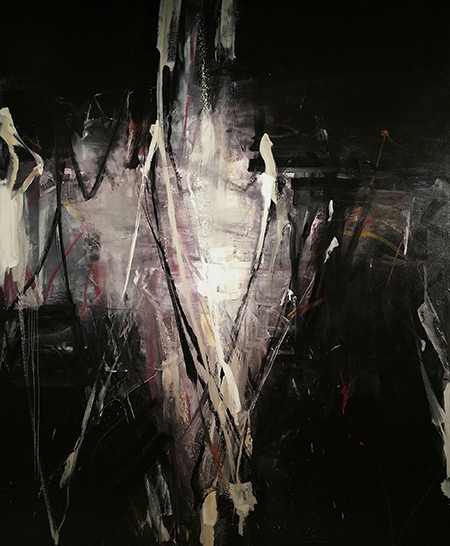
Continuing through February 25, 2017
Abstract Expressionism was marketed in postwar America as quintessentially American, with its heroic individualism, symbolized by the “cowboy,” Willem de Kooning’s reference to Jackson Pollock. It was an easy advertising sell in the prosperous yet insecure Cold War to American consumers. Also, as recent revelations have come to light, to the dazed citizenry of the war-shattered economies of the rest of the world, thanks to the CIA. AbEx of course owed certain ideas — distortion, improvisation, antinaturalism — to Surrealism and Expressionism. It also was indebted to the Asian traditions of calligraphy and a non-perspectival space modulated by tone and color.
Tom Lieber, who was educated in Illinois and California and now lives in Hawaii, has explored Abstract Expressionism for forty years. Of the ten large paintings here, the largest two being ten feet tall, shows no wavering from that commitment. His enthusiasms run beyond the usual New York School suspects to include European modernists such as Giacometti and Morandi, who worked while “in touch with their own energy — their own line and gesture — and weren’t addressing ‘Art,’ like Jasper Johns or Warhol, for instance, who were revolting against what came before.”
Lieber’s large and dramatic abstractions contrast his kinesthetic calligraphy of energetic black brushstrokes and loosely painted veils and scumbles of subdued color — grays, tans, ochers and greens, with occasional touches of red — that suggest an Asian landscape painting palette. (The blue of “Turquoise Swell” perhaps derives from the Hawaiian Pacific.) A black triangular arrow form or symbol pointing downward appears in no less than four pieces here: “Red Black Spade,” “Red Black Tip,” Spats,” and one of the pair of untitled monotypes. The basic V form pops up in other works, including the somewhat Johnsian “Black Veil,” and reflects Lieber’s interest in martial arts, massage and meditation. Leiber also clues us in that it “can be seen as symbolizing the lower torso — the standing body’s center of gravity.” While the works’ size, scale and gesture are powerfully dramatic, don’t overlook the telling details — the lively, painterly grace notes in muted color — of these monumental works.
